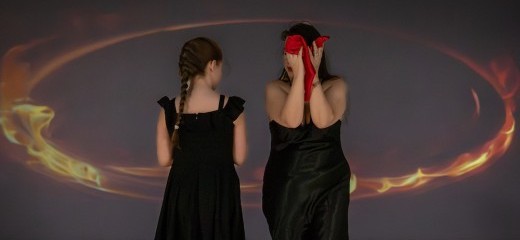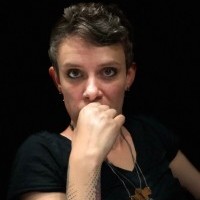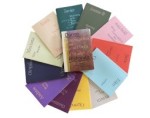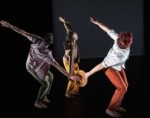
The Kinetic, the Femme, The Political: Lineage in motion.
by Emilee Lord
It’s one thing to notice how and where you are not being seen or are being pushed aside. It is altogether another thing to do heavy research into it for two years and then perform your findings. Anabella Lenzu is preparing to premiere her new work, Listen to Your Mother, at LaMaMa NYC on May 16th. Her approach to this work, an interdisciplinary piece of dance theater, has pulled from her dance training and research, the way she straddles being a mother, an immigrant, and an artist, and how she seeks to form community with others who share these identities.
Lenzu, originally from Argentina, is classically trained and studied modern dance with Humphrey/Limòn and Graham. She is a dancer, choreographer, scholar, and educator. Because the making of this work was so research heavy, yet so personal, I sat down with Lenzu to discuss the process, motherhood in dance, and the layers of genealogy in the work.
Process
Over the last year, Lenzu interviewed 30 women, ages 30 to 80, many of them immigrants and all of them mothers and dancers. She said that when she sent the transcript back for final permission to use their words, most of them wanted almost 50% cut. “It was all the juicy, controversial parts, because there are still consequences for the truth. So there’s still this fear in talking about the uneven [representation in the] field.”
I was curious about how the interviews exist alongside the performance. Originally, Lenzu wanted to have the bodies of mothers of different ages on stage with her, but with only one grant to support the work, she chose to conduct interviews instead and use the voices as a sound score. She calls it the ‘Greek Chorus.’ “The whole struggle of being a mother, but being an immigrant, creating your own community in a foreign land and in dance is so much work,” she reflects. The interviews act like an archive and a community. “All these stories inspire me to go a little bit deeper and rethink the format. My body is my vessel, and now it is a vessel for these stories,” Lenzu shared.
Motherhood
Lenzu says she’s been told that motherhood is not sexy or marketable. “I quote that in the show. So, motherhood is not sexy. Motherhood is an old topic that nobody cares about. I wrote a big speech that is called ‘Mothers and Beggars.’ It’s a political thing like I am Evita Perón. The show is a testimony to many different layers of struggle, and not just to complain. Nobody wants to hear a woman having a hysterical talk, especially on the stage. But I have to do it. It's my duty. The only place that I feel that I have control and agency in my life is on the stage. Perhaps people listen to me there. That's why I have to do the show.”
When asked about who this show is for or who she may be speaking to, she said, “People who are not mothers or artists will see what is behind the scenes. I invited friends who are not parents or female-identified to see how I deal with these testimonies and my role in society. Having feedback is important for me so this is not one channel.”
I remember, in a conversation about a year ago, Lenzu talking about the mother's bag and everything in it. She was asking mothers what they carried. This seems like a particular point of research that gets to cultural and emotional material as well as choreographic content. When asked where else this work began, she answered with drawing– “I started drawing maybe 2016-2017. I started with feminine symbols first, the vagina and the mouth. I was interested in how the vagina is connected to the mouth and to the heart. When I started to do these drawings, I was improvising. Then, I took away the papers and crayons. Took just the movement.”
We spoke about her rejection of certain imagery, particularly the domestic object or space. She refuses the images that further define the woman as a domestic laborer. Rather, she wanted to imbue this work with the magic and ritual inherent in the power of the mother’s body. She also spoke about using a kind of ritual or primal aesthetic to counterbalance the outspoken politics of the work.
Genealogy
The sets of female lineage or genealogy in this work are worth unpacking. Lenzu is dancing with her daughter, Fiamma, for the first time. Of this collaboration, she said, “I was thinking about what I want to pass on to another female, to the next generation, to my daughter. The first thing was a national dance in Argentina we call Zamba. In this, we use a handkerchief, which has a lot of lexicon; it's a folk dance. For me, dancing this is me being Argentinian. And I want her to have this. I reorganized all the gestures in my own way to pass her down this Zamba.”
Lenzu also taught Fiamma a solo she choreographed at 16. “It was an excuse to teach her my mystery, my craft. This choreography challenged her technically. She was not prepared to do this, but we still [will] perform it. And it's about that, actually. It's about me coaching her, looking at her, her looking for approval. And I treasure that because I think maybe she won't be a dancer. She's 10 years old. So this time is precious. It's the only time that she's going to be 10. It's the only time that perhaps we're going to perform. And I treasure that, the process, to spend [time] with her.”
Another lineage at play here is that of Isadora Duncan and her piece La Mère. “Mother” is part of a trilogy of dances that Duncan created around 1923, to the Etudes of Scriabin. Lenzu discovered this work while interviewing Catherine Gallant, a choreographer and dancer who specialized in Duncan. It profoundly affected Lenzu, who asked Gallant to coach her on the choreography.
Gallant wanted Lenzu to have the space to interpret the dance and make it hers. For Duncan, who was a mother and whose two kids died in an accident at a young age, this piece was of grief. For Lenzu, it couldn’t be about death, but it could be about care and putting children to sleep, about having babies and seeing them grow up and leave. It could be about life.
“I'm the fifth generation. It was Isadora Duncan, Anna Duncan, Julia Levine, Catherine Gallant, and myself. So, this solo is part of the show. It's not just me, the repertory to Fiamma, but it's also Isadora's repertory through my body.”
There’s a difference in her work with her daughter's presence. Lenzu says she has never performed these kinds of emotions on stage in this way before. And this is perhaps just as vital as the outrage, politics, and power.
“The world is on fire. We have to protest, we have to be political, we have to be active, but we also can show the other side of humanity: compassion, patience, and care. And I feel that I could not do this without Fiamma on the stage. Motherhood is about nurturing. Whatever I'm teaching, whatever I'm doing is about deep care as well.”
Listen to Your Mother, Anabella Lenzu, LaMaMa, NYC, May 16-19, 7 pm
By Emilee Lord
May 8, 2024









